April 2022 saw spring finally reach the Cairngorms National Park. Similarly to March, high pressure dominated, and although it was a little cool initially, we enjoyed lots of sunshine and blue skies, with generally light winds, and just a few cloudy, drizzly days, and with temperatures often creeping up into the teens, and just a few overnight frosts, it was a near perfect wildlife-watching month.
The days really are lengthening nicely now, with around 14 hours of usable daylight, but dawn (for the Black Grouse lek) is now a slightly less sociable 5:30 am, so if this species is on your 'wish-list', be prepared for an early start...
Although many of the winter visiting birds had departed by mid-month, the ever increasing influx of summer migrant birds north into this area helped bird species day-lists creep ever higher, and 40+ species would not be uncommon on a full day (10 hours+) local safari, or considerably more if you include a visit to the nearby Moray coast, whilst full day mammal species day-lists can creep up towards double figures, with early starts usually providing best results for the shyer ones.
The dawn chorus is at it's best in April, and it is always great to have your early start rewarded by getting to enjoy hearing the resident birds being joined by the newly arrived migrants like Willow Warbler, Chiffchaff, Blackcap and Tree Pipit.
Add to this the first butterflies and bees on the wing, the explosion of spring flowers into full bloom and frogs and toads on the move, and the feelgood factor of this time of year is hard to beat...
 |
| Early spring at a picturesque local upland loch |
To give you an idea of what you may realistically hope to see if you are considering a future April visit, I hope the following more detailed information, illustrated with photos taken at sites in and around the Cairngorms National Park by myself, my friends or my safari clients this month and in previous April's will help....clicking on the picture enlarges it to full-screen.
Local speciality/upland bird species seen regularly during the month included:
Black Grouse (at, or soon after dawn), Osprey, Red Grouse, Ring Ouzel, Slavonian Grebe, Red-Throated Diver, Black-Throated Diver, and Dipper, with several decent sightings of Golden Eagle and White-Tailed Eagle , just a few brief glimpses of Crested Tit and Crossbill...and on the 17th, a mid-morning forest drive produced a fortuitous first sighting this year of a male Capercaillie...
Snow Buntings were seen at low level sites early in the month when there was snow about, but seemed to retreat high up to the mountain tops, as the snow line receded...where Ptarmigan can also sometimes be seen...
Winter visiting birds were represented by a few remaining family groups of Whooper Swans, flocks of Greylag and Pink-Footed Geese, wildfowl such as Wigeon and Teal, and a few lingering Bramblings, but most had departed by mid-month...
Summer migrant birds flooded in throughout the month, with the first sightings this year of Osprey, Wheatear, Common Sandpiper, Sand Martin, House Martin, Swallow, Willow Warbler, Chiffchaff, Blackcap, Tree Pipit, Redstart and Cuckoo, to name just a few...
A good variety of seabirds, auks, waders, wildfowl and Geese can be enjoyed at the Moray Coast or the nearby inland lochs...
Mammal species seen regularly included:
Red Deer, Roe Deer, Reindeer, Rabbit, Brown Hare, Red Squirrel, and Feral Mountain Goat, whilst Mountain Hare were seen a few times, but became a little trickier as they morphed into their spring coat..and both types of Seal were seen at the nearby Moray coast...
April 2022 bird sightings in more detail:
Up on the moors....
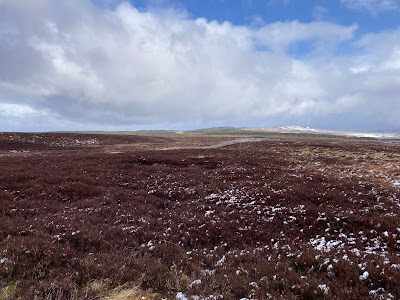 |
| A local upland heather moorland |
 |
| Lekking Black Grouse |
 |
| Lekking Black Grouse |
April is definitely THE month to see Black Grouse, and dawn (now around 5:30am) visits to local Black Grouse leks usually delight and amaze my safari clients with as many as 8 blue-black cock birds seen 'performing' in spectacularly aggressive fashion, their incredible bubbling and whooshing sounds drifting across the moor, and late in the month, we are often lucky to witness the hen birds walking among them, watching the action, and presumably 'rating' the contestants, only around 20% of whom will 'get lucky', and previously we have even been lucky enough to see them mating with their chosen partner - a truly fantastic wildlife spectacle and a great way to start the day!
 |
| Female Red Grouse |
 |
| Male Red Grouse |
Our local moorlands continued to echo with the characteristic cackling calls of the cock Red Grouse, many of whom were seen still actively displaying from raised positions, with red 'eyebrows' aglow, presumably 'guarding' their territory and nesting female, and from mid-month I saw very few hen birds, suggesting that many may already be incubating eggs.....
On the lochs...
 |
| A local loch |
 |
| A local pair of Ospreys reunited |
 |
| Osprey |
 |
| Osprey |
One of my most eagerly-awaited wildlife moments every year, is the return of our local Ospreys to their nesting sites, and these impressive birds of prey are always popular with my safari clients, with their dashing good looks, large size, aerial acrobatics and spectacular plunge diving to catch fish. Many of our local pairs were reunited by mid-month after a winter apart in West Africa, and were soon seen building up their nests with sticks, chasing off intruders and mating frequently, and by the very end of the month some of the hen birds appeared to be incubating eggs as the cock birds began to perform all of the fishing duties, whilst the females presumably carried out brooding duties..
.jpg) |
| Red-Throated Diver |
 |
| Black-Throated Divers |
 |
| A very rare close-up photo of a Black-Throated Diver |
 |
| Slavonian (Horned) Grebe |
 |
| A pair of Goldeneyes |
Also on the lochs (and rivers), we must not forget our breeding Goldeneye population , and I was fortunate enough to see them regularly this month, with many of the dapper males still performing their unique and spectacular 'head-banging' mating display!
Up in the glens...
 |
| On safari in a beautiful local upland glen |
 |
| Common Buzzard |
 |
| Red Kite |
 |
| Golden Eagle |
 |
| White-Tailed Eagle |
Up in the local glens, it is worth noting that bird of prey sightings usually become less frequent during the longer days of spring and early summer, with many of the female birds nesting and many more hours of daylight available for hunting meaning that our chances are reduced. However, we still managed reasonably regular sightings of Osprey, Common Buzzard, Red Kite, Peregrine, Kestrel and Sparrowhawk, and also a few views of Goshawk, Golden Eagle and White-Tailed Eagle, though I am still yet to see a Merlin this year...
In the forests...
 |
| Nice morning light in a local ancient Caledonian pine forest |
 |
| Male Capercaillie |
 |
| Male Capercaillie |
With no 'rogue' birds in this area to go for currently, and numbers confirmed to be declining to dangerously low levels, Capercaillie sightings are now much more difficult to come by, and sadly, we only managed a single, very brief mid-morning sighting of one male bird this month, despite many walks and slow drives through suitable Caledonian forest habitat, where we had been successful before...
Please note: In order to help protect them and keep sensitive sites 'off the radar', I no longer take clients on specific Capercaillie-hunting missions, and although we do visit suitable areas of forest, I would only rate our chances of seeing one on my safaris as "very slim" at best, and now we are into 'lekking' season, I will be 'responsible' by staying out of 'sensitive' areas at dawn through April and May to allow this now very rare and elusive bird to (hopefully) lek and breed in peace....
 |
| Crested Tit - Photo from April 2020 |
Still in the forests, Crested Tit sightings became much more difficult to obtain this month, with one or two birds seen early on using forest feeding stations on the colder mornings, but generally they were pretty elusive, seemingly quietly going about their business breeding.....and I should point out that you really need to be familiar with their 'chuckling trill' of a song to have a realistic chance of seeing them... but I usually plan a short Caledonian forest walk in order to give us a chance...
 |
| Male Crossbill |
 |
| Female Crossbill |
Continuing the forest theme, unusually, we actually did pretty well for Crossbill sightings , though most of them were of the typical and rather annoying fly-over variety, we also had a couple of better views, and (unusually!) on the 1st and the 17th, we even managed a few photos, when birds perched obligingly for a few seconds!
On the rivers...
 |
| A local river |
 |
| Dipper |
It was noticeable that there were increased occurrences of male Dippers seemingly delivering food and additional nest material to the now well hidden female birds at their nest sites , usually underneath bridges or under high , overhanging banks...and we also witnessed a few instances of rival males having territorial disputes....
Up in the mountains....
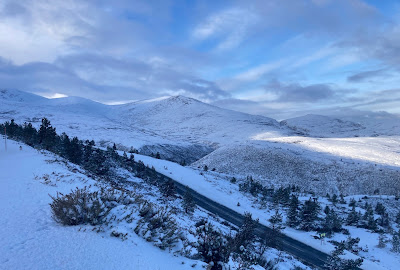 |
| The Cairngorm Mountains can still be snowy in April |
Although I did not walk up to the the summit area myself this month - the Cairngorm Funicular railway is still out of action - visits to the ski centre car park early in the month, while the snow was still down to lower levels, gave us some good views of a few lingering Snow Buntings, but they seemed to retreat high up to the mountain tops as the snow line receded.... Those that do walk up though, can get some decent sightings of Ptarmigan as well, with both species now morphing into their summer plumage...
 |
| Male Ring Ouzel |
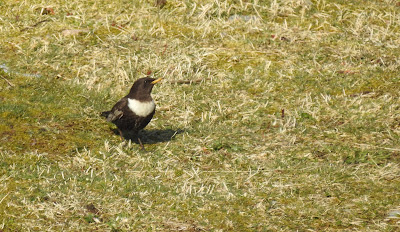 |
| Male Ring Ouzel |
At slightly lower levels ( but still generally at 1,500ft/450m +) Ring Ouzels - sometimes called the Blackbird's mountain dwelling cousin - always prove to be popular with my safari clients, presumably because not many will have seen them locally, as they tend to breed only in remote upland areas well away from human disturbance, and can be quite tricky to find. We are fortunate in having plenty of suitable habitat for them in this area though, and we are often able to get decent views and sometimes photographs of newly-arrived male and female birds .....
On farmland....
 |
| Typical local rough farmland |
 |
| Curlew |
 |
| Lapwing |
 |
| Oystercatcher |
Lots of waders have now returned to their spring/summer breeding grounds on local farmland, with Oystercatcher, Lapwing, Golden Plover and Curlew all being noted.....
Lingering winter-visiting birds seen in our area this month included:
 |
| Whooper Swan |
 |
| Pink-Footed Geese |
 |
| Greylag Goose |
A few Whooper Swans, Grey Geese (Greylag and Pink-Footed), and Bramblings ..though these are all likely to depart this area soon....
Other good/scarce birds seen/reported locally this month included:
A Glaucous Gull, a Green Woodpecker, a Black Redstart, and a few Whimbrel....
A few photos of more common birds seen locally this month:
 |
| Male Pheasant |
 |
| Robin |
 |
| Song Thrush |
 |
| Common Gull |
 |
| Male Chaffinch |
 |
| Great Tit |
 |
| Great Spotted Woodpecker |
 |
| Common Sandpiper is seen regularly by water here from April -August |
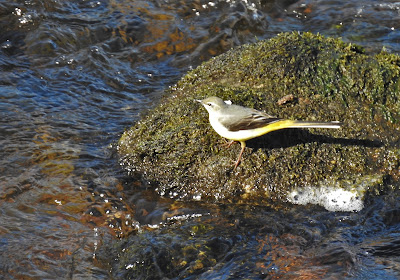 |
| Grey Wagtail |
 |
| A pair of Goosanders |
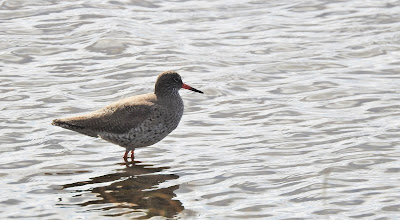 |
| Common Redshank |
 |
| Meadow Pipit by Ian Dennis |
 |
| Tree Pipit |
 |
| Chiffchaff by Steve Nicklin |
Adventures 'out of area':

Birding at the ruggedly beautiful Moray coast
 |
| Fulmar by Steve Nicklin |
 |
| Gannets by Steve Nicklin |
 |
| Kittiwake by Steve Nicklin |
 |
| Razorbills and Shag |
 |
| Shags |
 |
| Black Guillemots |
 |
| Male Wigeon |
 |
| Little Grebe |
 |
| Male Ring-Necked Duck |
The very scenic Moray coast is only about a one hour drive north of Aviemore, and my April trips to favourite reserves, lochs, bays and harbours provided good views of resident and wintering birds such as Greylag Geese, Pink-Footed Geese, Whooper Swan, Wigeon, Teal, Scaup, Pintail, Bar-Tailed and Black-Tailed Godwit, Golden Plover , Rock Pipit, Redshank, Oystercatcher, Turnstone, Curlew, Dunlin, Eider, Red-Throated Diver, and Ringed Plover, and a good selection of scarcer birds in the form of a few White-Billed Divers, a King Eider, a summer-visiting Garganey and a Ring-Necked Duck.
Whilst on the 'stacks' , Shag, Gannet, Fulmar, Kittiwake ,Razorbill, Common Guillemot and Black Guillemot were all seen to be nesting already. It was noticeable though, that some of the winter -visiting species were in smaller number than last month, and of course, many of these birds will disappear off north to their breeding grounds soon...
 |
| Yellowhammer |
April 2022 mammal sightings in more detail:
 |
| Red Deer stags |
Red Deer always prove popular with my safari clients. Being an iconic animal of the Scottish Highlands, the 'Monarch of the Glen' is on most visitors 'wish-lists', and we usually manage to see them regularly in large same-sex herds in upland glens this month, though views are usually quite distant, and many of the stags have now lost their old fully-grown antlers, and are growing a new set...
 |
| Mountain Hare |
Despite most of them now sporting their mottled white and blue-grey spring outfits, Mountain Hares usually seem to be the one to beat in our 'mammal of the day' awards in April - if we get to see them - far from guaranteed- as they certainly become tricky to find among the mottled white and blue-grey rocks of their upland homes!!
It should be noted though, that most of our views are at range through my telescope, and that a closer view or photographic opportunity usually involves some considerable amount of rough uphill walking, sometimes on snow, yes, even in April!
 |
| Feral Mountain Goats |
Feral Mountain Goats too are only found in a few remote upland areas of the UK, and we are often fortunate enough to have good views of these wild looking, multi-coloured creatures, with the fast-growing youngsters now almost as big as the adults...
 |
| Red Squirrel |
Seeing a Red Squirrel is always a treat, especially for those who don't have them locally - sadly, most UK residents - but we have good numbers here, and we were fortunate enough to see them regularly this month, sometimes at forest feeding stations, and sometimes running around or climbing trees...
 |
| Roe Deer |
 |
| Brown Hare by Steve Nicklin - Photo from April 2018 |
As spring tends to reach us a little later this far north, where Brown Hares are concerned, we tend to get 'Mad April Hares' rather than 'Mad March Hares'' , and that proved to be the case this month, with lots of frisky behaviour being witnessed.
 |
| Seals at the Moray coast |
As I mentioned earlier, both types of seal can be seen at the nearby Moray coast at a number of well known 'haul-out' sites. Please give them plenty of space though, and avoid disturbing them....
 |
| Carrot time for Murdo |
Hairy Highland Coo's always prove to be popular with my safari clients, especially those who do not have them close to home, so don't be afraid to ask me if you fancy going to see them, and maybe even get to feed and 'pat' them, as I have a couple of great sites....
Rare/nocturnal mammals:
I get a few enquiries about the possibility of seeing Badgers and Pine Marten from my safari clients, many of whom I suspect are unaware that they are actually a largely nocturnal creature, and although we do get the occasional (maybe one or two a year) dawn glimpse of one, you would definitely have a much higher chance of seeing them at a specific dusk Badger/Pine Marten watching hide - Please contact me for more information.
Similarly, our inland Otters too are mainly active during the hours of darkness, and again, although we do get a few early-morning sightings on local lochs and rivers each year, looking for them feeding in a suitably quiet, kelp - filled bay on the coast on a rising tide, but at any time of day, would give you a much better chance.
Whilst we are still on the 'tricky to see stuff', the Scottish Wildcat too, as well as being incredibly rare now, is also generally nocturnal, and the fact that I have had a mere handful of (dawn or dusk) sightings in 17 years of providing wildlife safaris should give you an idea of how difficult they are to see.
Other wildlife:
 |
| A Wood Ant nest |
Some of the warmer days saw a few pioneering butterflies - Small Tortoiseshell, Peacock, Comma and Small White - on the wing, joining the increasing numbers of bees, the first activity this year was noted in the Wood Ant colonies, and a few Bats were seen hawking insects over water at dusk....
 |
| April is lambing time in this area |
News:
The BIG news is that all tourism/hospitality/activities in Scotland are open , are now largely free of restrictions and that I have now completed a full year of (thankfully!) increasingly busy and extremely enjoyable safaris with clients with no major issues arising.
With all national travel restrictions lifted too, Scotland is officially 'open for business' for visitors from all over the UK, and from abroad.
At the time of writing, as COVID is still around, and as restrictions have only recently been relaxed, we are still operating at reduced capacity, and are still trying not to mix unconnected groups unless this is unavoidable, so we are currently recommending 'exclusive' safaris, at a small extra cost.
For those considering a visit, these wildlife/outdoor tourism websites may prove useful:
https://www.gov.scot/collections/coronavirus-covid
NatureScot (outdooraccess-scotland.scot)
Can Nature Help Health? | Nature Prescriptions - YouTube
Scotland, Yours to Enjoy. Responsibly. - YouTube
Cairngorms National Park Authority
 |
| This far north, April sees our Daffodils still in full bloom. |
Summary:
I apologise for repeating myself, but It is only when I have time to sit down and compile my monthly wildlife sightings blog and look back through my notes and the photos that I and my safari clients have taken during the month that I really become aware of what a great time we have had, appreciate how lucky I am to live and work here, and see how successful our safaris have been.... and it would appear that April 2022, turned out to be a really excellent and very enjoyable month for wildlife watching in and around the Cairngorms National Park. With the returning summer visiting birds flooding northwards to join our local speciality resident species, the dawn chorus, the days lengthening, flowers (finally!) blooming, the huge variety of unique and stunning scenery and the weather ( generally! ) improving, I can honestly say that I would not want to be anywhere else in the world than here in the majestic Scottish Highlands at this time of year, and it was especially nice this month to be able to show it all off to my first overseas clients for over 2 years, many of whom were visiting Scotland for the first time... happy days!
Reviews:
https://www.tripadvisor.co.uk/Attraction_Review-g186537-d3335134-Reviews-
Buying my photos:
Prints of any of the photos (taken by myself) shown on this blog, going right back to 2015, reproduced on high quality photographic paper, with a choice of sizes up to A3, and satin pearl or glossy finishes available, can now be purchased from me at very reasonable prices. So if you see an image that might look nice in a frame (provided by yourself) on your wall, please make a note of the year and month of my blog in which it appeared, and email me for more information.
 |
| Safari gift voucher |







No comments:
Post a Comment